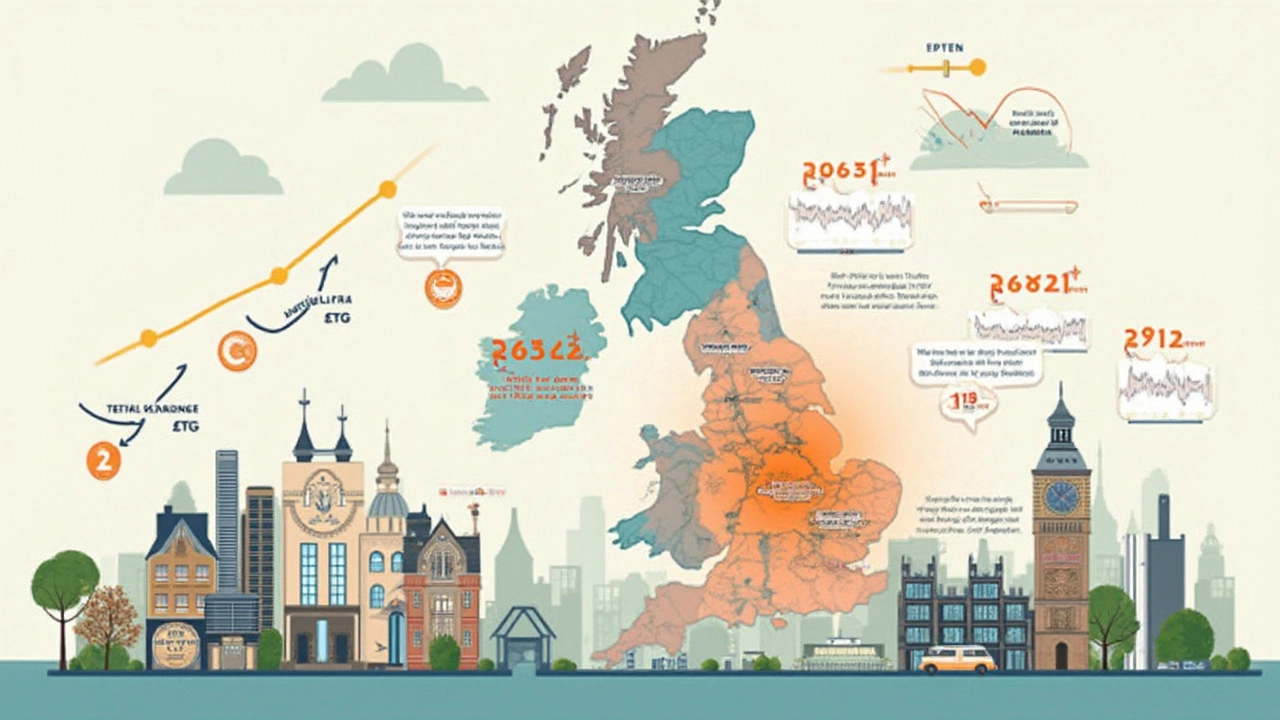Upper Class Income: What It Really Means in 2025
 Jun, 4 2025
Jun, 4 2025
When you hear "upper class income," do you picture private jets or just more wiggle room in the budget? The thing is, being called "upper class" in 2025 is all about numbers—and those numbers might be higher than you think.
Right now in the U.S., most experts say you need at least $220,000 per year for your household to be seen as upper class. That’s before taxes, by the way. But this number swings wildly depending on where you live. If you’re in San Francisco or New York, you’re probably looking at $350,000 or more to get into that club. Small towns? $150,000 could put you in the top slice.
This upper class label isn’t official, but banks, economists, and investment advisors use it to help benchmark wealth and financial planning. Why does it matter? If you aim for higher income, it changes your investment strategy, your risk, even how you think about taxes and spending. So don’t just daydream about a big paycheck—knowing the cutoff points helps you set realistic goals and avoid lifestyle inflation. More details coming up—especially for folks who want to climb that income ladder without making all the usual mistakes.
- Defining Upper Class Income in 2025
- Location Matters: Why Geography Changes the Game
- High Income vs. True Wealth
- Smart Moves for Those Eyeing the Upper Class
Defining Upper Class Income in 2025
If you’ve ever wondered where the line is between just getting by and having what people call an "upper class income," it’s more clear-cut than you might expect. In 2025, this isn’t just some number pulled out of thin air—it’s calculated from government data, surveys, and what banks look at when deciding if your finances are really above the norm.
For the U.S., the upper class income definition depends on your household size. For a family of three, Pew Research and the U.S. Census point to a household income roughly double the national median, which sits at about $74,600 as of late 2024. So, an upper class household is bringing in at least $220,000 before taxes. Single earners will hit that mark at a lower number—about $150,000—but for bigger households, you may need even more to stay ahead.
Here’s a quick breakdown based on the latest data:
| Household Size | Lower Limit for Upper Class (USD) | Typical Maximum (USD) |
|---|---|---|
| 1 | $150,000 | $300,000+ |
| 2 | $180,000 | $350,000+ |
| 3 | $220,000 | $400,000+ |
| 4 | $250,000 | $450,000+ |
This doesn’t mean you’re driving Lamborghinis or have a golden toilet—just that you’re likely in the top 20% of earners. The government usually sets this benchmark by looking at national income percentiles. Hitting this level means you’ve got extra cash to invest, save, and spend. But rising costs, taxes, and family needs can eat up more of that income than most realize.
Want to know if you stack up? See where your income falls using percentile calculators—several reliable versions show up with a quick online search. And don’t ignore the details: a big part of reaching and keeping upper class income is about making good choices along the way, not just cashing big paychecks. More on that as we go.
Location Matters: Why Geography Changes the Game
You might've heard someone say, "That kinda money wouldn't get you far in California!" and honestly, they're right. Where you live can crank up or cool down what counts as an upper class income. It's because the cost of living swings big, depending on the city or state. Stuff like housing, daycare, even grabbing a burrito can eat into your bank faster in some places compared to others.
Let’s look at the actual numbers for 2025. Take a peek at this table to see how much households need to hit upper class status in a few cities:
| City | Upper Class Household Income Needed (2025) |
|---|---|
| San Francisco, CA | $375,000 |
| New York, NY | $350,000 |
| Austin, TX | $225,000 |
| Chicago, IL | $210,000 |
| Columbus, OH | $155,000 |
| Birmingham, AL | $140,000 |
See the gap? A huge paycheck in Alabama looks just average in the Bay Area. If your goal is to reach or grow past these numbers, you need to think about location. Even if you're making six figures, renting a basic place in Manhattan could swallow a third of your income, while in Ohio you might afford a big house and still save plenty.
Here are a few practical things to consider about this whole location game:
- Taxes hit harder in some states. California and New York love their high income taxes, while Texas has none.
- Public services—better schools or public transport in pricier cities can save you money elsewhere.
- Your dollar stretches further for things like groceries, utilities, and insurance outside high-cost metros.
If you’re planning your move or working remotely, weighing these income differences is a smart play. The real "upper class" trick? Mix a solid income with a city that lets you actually enjoy it.

High Income vs. True Wealth
Making a six-figure salary can make you feel rich, but there’s a huge gap between high income and actual wealth. It’s shocking how many folks earning $250,000 or more are still living paycheck to paycheck. A 2024 survey by LendingClub found that about 33% of people making over $200,000 a year say they have little or nothing left at the end of the month.
Why? Because spending tends to chase income. The more you make, the more you might spend on bigger homes, fancier cars, private lessons for your kids—even pricier groceries. That’s called "lifestyle creep," and it eats your financial progress if you’re not careful.
Here’s a quick look at how high income can get confused with wealth:
| Person A | Person B |
|---|---|
| Salary: $120,000 Spends: $110,000 Savings: $10,000 Net Worth: $25,000 | Salary: $80,000 Spends: $50,000 Savings: $30,000 Net Worth: $350,000 |
Even though Person A earns more, Person B is actually wealthier with a bigger safety net and better options for the future.
If you care about building upper class income into true financial security, focus less on your paycheck and more on growing your assets—like investments, retirement funds, and even having a paid-off house. Wealth is what you keep, not just what you earn.
- Track your net worth regularly—apps like Personal Capital make it easy.
- Automate your savings, so you invest first and spend what’s left.
- Don’t boost your spending every time your pay jumps; bank some or all of the difference.
- Remember, most people don’t get rich from salary alone—it’s building and holding assets that counts.
If you’re gunning for a new definition of success, think about building real wealth—not just hitting a certain yearly salary.
Smart Moves for Those Eyeing the Upper Class
Hitting that upper class income level isn’t about luck or long hours alone. You need some strategy, especially if you want to keep more of what you make. One wild stat: according to the Federal Reserve’s 2024 Survey of Consumer Finances, about 33% of U.S. families earning over $200,000 a year said their biggest worry was "not saving enough." It’s easy to look rich but feel broke.
If you really want to join and stay in the upper class, here are some practical moves that actually work:
- Invest early and often: Don’t park your money in a checking account. Let it work for you in broad-market index funds, real estate, or other growth assets. Vanguard’s data shows the average upper-class household puts over 25% of its wealth into investments, not just salary or savings.
- Automate your savings: Set up auto-transfers into retirement or investment accounts so you never "forget" to pay yourself first. It’s the oldest trick in building wealth, but it works.
- Think after-tax, not just before-tax: High earners get hammered on taxes. Max out IRAs or 401(k)s, and know your state’s tax laws. In 2025, the top federal tax rate is 37%. That’s a huge bite if you don’t plan ahead.
- Live below your means (really): Just because you can buy a new car every two years or move up to a bigger apartment doesn’t mean you should. Want proof? The best-selling car for U.S. millionaires is still the Ford F-150.
- Diversify income streams: Most upper class folks don’t rely on a single job. Rental property, small business, stocks—they stack several income streams to hedge against risks.
And a classic reminder worth repeating, as David Bach, author of 'The Automatic Millionaire' said:
"You don’t get rich by what you earn. You get rich by what you don’t spend."
Check out these 2024 stats on how the upper class keeps their net worth growing:
| Action | % of Upper Class Doing This |
|---|---|
| Automatic Investing | 68% |
| Owning Rental Real Estate | 41% |
| Maxing Out Retirement Accounts | 54% |
| Maintaining Emergency Fund (>6 months expenses) | 72% |
Smart financial moves aren’t flashy. They’re consistent, automated, and sometimes a bit boring. But that’s exactly why they work, year after year.
